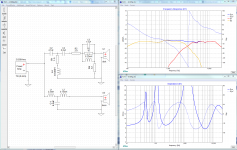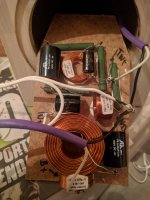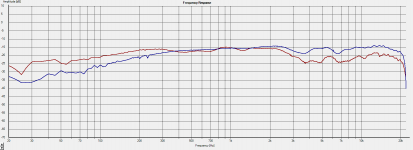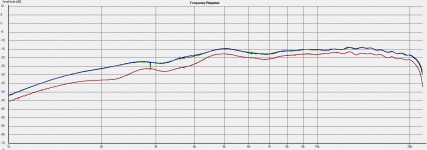Looks like it's the AR.com Ed Frias DIY kit. I have one of those too.
Now that is interesting! I have never heard of this kit even thow i have googeled the combination. The drivers was cosen by me in 2003 for a 3-way project. The reason for choosing the peerless drivers was mainly on looks
 Back in the 90s i was a fan of the look of the Infinity and Kirksaeter speakers with inverted dust cap
Back in the 90s i was a fan of the look of the Infinity and Kirksaeter speakers with inverted dust capThanks for sharing schematics and graphs!
-Why do I have two deep valleys (marked "daler") in the treble curve at 3k and 6.5k?
That's what you get with dome tweeters. It's a combination of diffraction at the edge of the front panel and diffraction from the front panel.
If you want to avoid this, I suggest changing to a horn loaded dome tweeter like the Morel CAT 378.
I have been designing now in XSim and tested a few ideas that I got from people in this forum, and other local norwegian forums and also some emails. I measured the tweeter a little off axis, like it would be realistic in my living room and then the big dips was not so big anymore. I ended up with a third order design with some correction on the tweeters oddities at the top.
After measuring the two speakers I can see that they are quite different. I have to check if I have soldered something wrong... But the bass response has to something else than the crossover. Could this be a dampening or leakage issue?
After measuring the two speakers I can see that they are quite different. I have to check if I have soldered something wrong... But the bass response has to something else than the crossover. Could this be a dampening or leakage issue?
Attachments
Last edited:
Hi,
Process of elimination.... Assuming the red curve is the problem speaker, (let's call it speaker "A"),
Can you take the tweeter from speaker "A" with the bad response and put in speaker "B"? If the bad response is now on speaker B - you have a bad or different tweeter. If the response is good on speaker "B" it must be the crossover / wiring on speaker "A".
For bass... I can't see stuffing levels affecting the bottom end response as much as shown. I'm not experienced enough to know if a leak can do the same. Have you got a foam gasket behind the frame sealing the flange of the driver to the cabinet?
I would do am impedance sweep measurement on both speakers and see if the port / driver resonance is the same to highlight where the discrepancy is between speakers.
Process of elimination.... Assuming the red curve is the problem speaker, (let's call it speaker "A"),
Can you take the tweeter from speaker "A" with the bad response and put in speaker "B"? If the bad response is now on speaker B - you have a bad or different tweeter. If the response is good on speaker "B" it must be the crossover / wiring on speaker "A".
For bass... I can't see stuffing levels affecting the bottom end response as much as shown. I'm not experienced enough to know if a leak can do the same. Have you got a foam gasket behind the frame sealing the flange of the driver to the cabinet?
I would do am impedance sweep measurement on both speakers and see if the port / driver resonance is the same to highlight where the discrepancy is between speakers.
I disconnected the bass driver and measured just the tweeter in both speakers, and speaker #2 has a lower output than speaker #1. I then put the tweeter driver from speaker #1 into speaker #2 to check if the problem was the tweeter drriver it self or the crossover. The problem was the tweeter.
I then modified the crossover attenuation adding a 3R3 in parallel with R2 and an other 3R3 resistor in series with R4. This moved up the response in line with speaker #1.
Blue: speaker #1
Read: speaker #2
Green: speaker #2 with tweeter driver from speaker #1
I then modified the crossover attenuation adding a 3R3 in parallel with R2 and an other 3R3 resistor in series with R4. This moved up the response in line with speaker #1.
Blue: speaker #1
Read: speaker #2
Green: speaker #2 with tweeter driver from speaker #1
Attachments
- Status
- This old topic is closed. If you want to reopen this topic, contact a moderator using the "Report Post" button.



